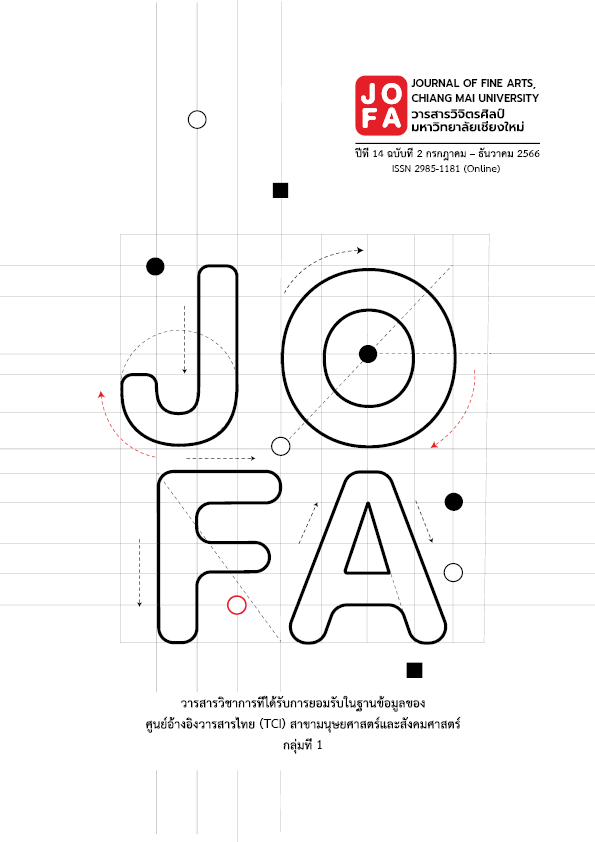Application of Neo-baroque Aesthetics to Create Animation Tell Story about Lanna Mural Painting Reflects Issues of Cultural Reproduction
Main Article Content
Abstract
The creative research project on ‘Application of Neo-baroque Aesthetics to Create Animation Tell Story about Lanna Mural Painting Reflects Issues of Cultural Reproduction’ has the objectives as follows: 1) to study and analyze on aestheticism in Neo-Baroque style for creating an animation to tell story of Lanna murals in order to reflect the cultural reproduction; 2) to run an experiment in applying aestheticism in Neo-Baroque style to the creation of an animation to tell story of Lanna murals to reflect the cultural reproduction; and 3) to present the created animation to tell story of Lanna murals to reflect the cultural reproduction in the style of an art exhibition.
As for the creation of the work in this project, I, the author, have concluded the perspective of cultural reproduction for the presentation of the work in accordance with the concept of Neo-Baroque that has the aims of creating the replica of the world with grandeur and extravaganza, hiding the beginning and the end of the story, referring to contents from other sources of references and contents of its own, presenting the feelings that cannot be explained, and having the center that moves along with audience. All the aforementioned tactics have been synthesized to be the directions for the creation of the animation art work that reflect personal perspective of the author to the issue of cultural reproduction.
The findings from the documentary research lead to the emergence of new ideas for the creation of the work in ‘animation-installation’ style that has various creative movements to expand the recognition senses of audience, enabling audience to be aware of movements on surface and on actual space. The movements are enlarged to overwhelm the space, which is the key concept of Neo-Baroque Art. The outcomes from the creation of the work in this project have met the predetermined objectives.
As for the academic advantages, the creation of the 3D computer graphic animation with the length of 19 minutes will enhance the author’s confidence in developing other animation works with contents relating to social issues. The documents used in the literature review and work analysis are academic works the contents of which have been summarized to be comprehensible for everyone that is interested in the topic in order to give directions for further studies on animation art works in Neo-Baroque style and other styles of creative story telling.
Article Details

This work is licensed under a Creative Commons Attribution-NonCommercial-NoDerivatives 4.0 International License.
References
Careri, G. (2019). Caravaggio Bernini Early Baroque in Rome: Bernini and Caravaggio the Body of the Soul. New York: Prestel.
Charoensin-o-larn, C. (2002). Sanwitthayā Khrōngsāngniyom Langkhrōngsāngniyom kapkānsưksāratthasāt [Semiology, structuralism, post-structuralism and the study of political science]. Bangkok: Vibhasa.
Ecstasy of Saint Teresa. (n.d.). Wikipedia. https://en.wikipedia.org/wiki/Ecstasy_of_Saint_Teresa
Egginton, W. (2010). The Theater of Truth the Ideology of Neo Baroque Aesthetics. California: Stanford University.
Kaewpenthong, C. (2013). The analytical comparative study of mural paintings at Wat Phumin and Wat Nong Bua Nan province [Master’s thesis]. Silpakorn University.
Lamarre, T. (2009). The anime machine: a media theory of animation. London: The University of Minnesota.
Ndalianis, A. (2004). Neo-Baroque Aesthetics and Contemporary Entertainment. London: Massachusetts Institute of Technology.
Pamakho, A. (2020). Yūdūaikan Phư̄nthī Thēknōlōyī lækhwāmpenʻư̄n: Manut ʻǢnalo̜k Nai Lōkdičhithan Kānyūrūamkan khō̜ng Manut kapwitthayākān Nai Phāpyon Chut Westworld [Coexistence, Space, Technology, and Others: Digital Human Anatomy Coexistence of Man and Science in the Westworld series]. Bangkok: Siamparitas.
Saint Francis of Assisi in Ecstasy. (n.d.). Wikipedia. https://en.wikipedia.org/wiki/Saint_Francis_of_Assisi_in_Ecstasy_(Caravaggio)
Swoboda, G. (2019). Caravaggio Bernini Early Baroque in Rome: Motion and Emotion Art in the Age of the Affects. New York: Preste.


